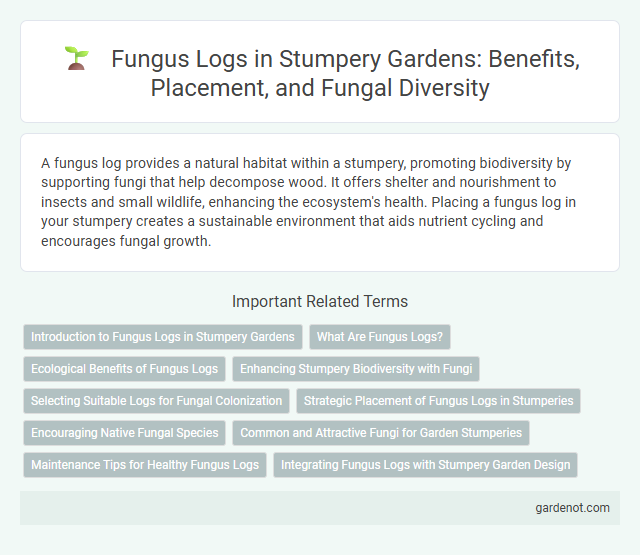A fungus log provides a natural habitat within a stumpery, promoting biodiversity by supporting fungi that help decompose wood. It offers shelter and nourishment to insects and small wildlife, enhancing the ecosystem's health. Placing a fungus log in your stumpery creates a sustainable environment that aids nutrient cycling and encourages fungal growth.
Introduction to Fungus Logs in Stumpery Gardens
Fungus logs are decaying wood pieces specifically placed in stumpery gardens to encourage the growth of diverse fungi species, crucial for maintaining ecological balance. These logs provide essential nutrients and habitats for various decomposers, enriching soil health and fostering biodiversity within shaded garden areas. Incorporating fungus logs enhances the natural aesthetic and supports the vital decomposition process, making them a key component in sustainable stumpery design.
What Are Fungus Logs?
Fungus logs are decaying wood pieces intentionally left in shaded, moist garden areas to create a suitable habitat for various fungi species. These logs provide essential nutrients, moisture retention, and a natural environment that promotes fungal growth and biodiversity. Gardeners often use fungus logs to enhance ecosystem health and support woodland creatures.
Ecological Benefits of Fungus Logs
Fungus logs serve as vital microhabitats that enhance biodiversity by providing shelter and food for numerous insects, fungi, and microorganisms. They play a crucial role in nutrient cycling by decomposing organic matter and enriching soil with essential nutrients like nitrogen and phosphorus. These logs also improve forest health by promoting symbiotic relationships between fungi and tree roots, which aids in water absorption and disease resistance.
Enhancing Stumpery Biodiversity with Fungi
Fungus logs play a crucial role in enhancing stumpery biodiversity by providing a natural habitat for various fungi species, which contribute to nutrient cycling and soil health. These decomposing logs harbor mycelium networks that support plant growth and attract diverse invertebrates, promoting a balanced ecosystem within the stumpery. Incorporating fungus logs increases fungal diversity, enriches microhabitats, and fosters ecological resilience in garden environments.
Selecting Suitable Logs for Fungal Colonization
Selecting suitable logs for fungal colonization in a stumpery involves choosing hardwood species such as oak, beech, or sycamore, which provide the ideal nutrients and moisture retention for diverse fungi growth. Logs should be partially decomposed and positioned in shaded, damp areas to create optimal microhabitats that encourage mycelium development and fruiting body emergence. Avoiding resinous softwoods and ensuring logs are free from chemical treatments enhances fungal biodiversity and colonization success.
Strategic Placement of Fungus Logs in Stumperies
Strategic placement of fungus logs in stumperies enhances fungal colonization by situating logs in shaded, moist areas that mimic natural forest conditions. Positioning logs near decaying organic matter promotes mycelium growth and supports biodiversity, creating a microhabitat for various invertebrates and mosses. Effective spacing between logs facilitates air circulation, reducing harmful mold development and optimizing decomposition processes essential for ecosystem health.
Encouraging Native Fungal Species
A fungus log creates an ideal habitat by providing decaying wood that supports the growth of native fungal species, promoting biodiversity within local ecosystems. Maintaining moisture and shade on the fungus log encourages mycelium expansion, which plays a crucial role in nutrient cycling and soil health. This practice fosters symbiotic relationships with surrounding plants, enhancing overall forest resilience and ecological balance.
Common and Attractive Fungi for Garden Stumperies
Common fungi like Turkey Tail (Trametes versicolor), Oyster Mushroom (Pleurotus ostreatus), and Artist's Conk (Ganoderma applanatum) are highly attractive for garden stumperies, adding vibrant color and texture to decaying logs. These fungi not only enhance the visual appeal but also promote biodiversity by supporting various insects and microorganisms within the ecosystem. Incorporating diverse fungal species on fungus logs creates dynamic, sustainable habitats that enrich garden environments naturally.
Maintenance Tips for Healthy Fungus Logs
Maintaining healthy fungus logs requires consistent moisture levels between 40-60% to promote optimal fungal growth and prevent drying out. Position logs in shaded, well-ventilated areas with natural humidity and avoid direct sunlight to maintain suitable microclimate conditions. Regularly inspect for contamination or unwanted molds, removing any decayed material promptly to support robust mycelium development.
Integrating Fungus Logs with Stumpery Garden Design
Integrating fungus logs into stumpery garden design enhances biodiversity by providing a natural habitat for mushrooms, insects, and fungi, promoting ecological balance. Fungus logs, rich in decaying wood and moisture, support diverse fungal species that contribute to nutrient cycling and soil health within the stumpery. Strategic placement of these logs among stumps and ferns creates textured, layered garden features that highlight natural decomposition processes and seasonal growths.
Fungus log Infographic

 gardenot.com
gardenot.com